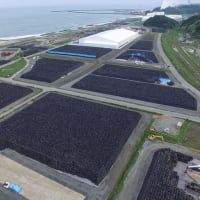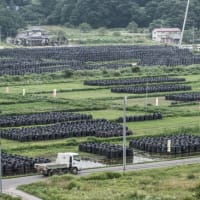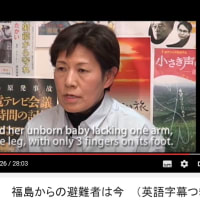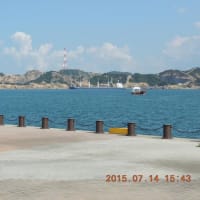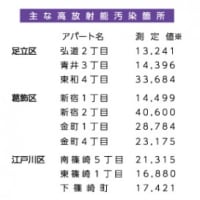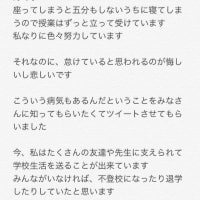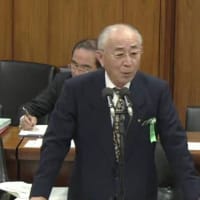『海外で受診する際に医師に渡す手紙』
被ばくに対する知識含み、専門家にわかりやすく説明
<手紙の主旨、使用方法など>
海外へ避難されている皆さまへ:海外で受診する際に医師に渡す手紙
http://sos311admin.blogspot.jp/2012/08/blog-post.html より全転載
2012年8月5日日曜日
英語ができる方でも、海外での受診の際には、説明が難しいものです。
原発事故によりどういう影響が及び、皆さんがどのような防御対策をされ、どのような症状が起こり、何故日本での受診が困難であったかなどを、医師の立場であれば知りたいだろうと思う範囲内で、簡潔に説明致しました。
また、日本の医師も海外の医師も、被ばくに対する知識が豊富でないため、チェルノブイリの経験から、どのような検査が必要であるかも説明致しました。
海外の受診時には、事前に頼めば、医療通訳をつけてくれると思います。(自費の可能性はあります。)そういった通訳の方でも、原発事故の影響を十分に説明できない可能性はあると思います。
この手紙を、受付でチェックイン時に提出され、診察前に医師に読んで頂くようにお願いされると良いと思います。
https://docs.google.com/document/d/1bs4GHH5A5l_qBV_3L9teUpkG6JRJq5xEuRlG16OWszQ/edit
**上記記事のコメント欄より
はなちゃん2012年8月10日 16:12
3.11に福島県内いた英国人に見せたら、これは大変役に立つと喜んでいました。
海外に避難した日本人のみならず、被災した外国人にも重要なものです。
素晴らしいお手紙を作ってくださり有難うございました。
<手紙の内容(全文を和訳)>
What to tell your doctor
海外で受診する際に医師に渡す手紙
https://docs.google.com/document/d/1bs4GHH5A5l_qBV_3L9teUpkG6JRJq5xEuRlG16OWszQ/edit (英文)より
親愛なる 医療機関様、
この手紙は、日本の原発事故の結果、放射線にさらされている可能性がある人々の医学的管理のための基礎的な情報や提案を提供することを目的としています。一部の日本人は、医療を求めるため、身を守るために海外に避難しています。あなたの患者がその一人です。
2011年3月11日に、日本の地震と津波に続いて、福島第一原子力発電所で3基の炉心溶解原発事故があった。日本政府が適切な対応を怠ったことにより、多くの人々が放射能汚染にさらされ続けています。福島県外でも同様です。
放射性プルーム(放射能雲)が東京とその周辺の関東地域を通過したのは、3月14日、 15日 、 20日と21日であった。しかし、東京の放射線レベルは、無視できるレベルであるとの政府の見解のために、多くの人々、子供たちが日常的に学校に行き、普通の生活を送っていた。
日本の医療社会では、医師が何を分析し記入することができるか、政府によって確立された診断のガイドラインにより命令された内容でしか決定できません。急性放射線症は、それが高い放射線照射量にさらされる原発労働者で該当する症状が見られる場合のみ、ただ一つ承認された診断です。
したがって、病院と医師には、どんな「放射線被曝に対する、テストあるいは治療」も拒絶するしくみがあるので、多くの人々に可能性ある放射線関連の徴候のために医療を求めることができません。
汚染された食品や人やモノのため、日本の広範かつ徹底した輸送システムを介して日本全国に広がる放射能汚染は、かなりの程度があります。汚染された米と牛乳が汚染されていない製品とブレンドし、全国に循環されています。また、放射性がれきは、東京を含む日本各地で焼却され、基本的かつ効果的に放射性物質を大気中に再拡散させています。
放射性ヨウ素は、甲状腺癌を引き起こすことが知られています。しかし、福島第一から放出された放射性核種は、それだけではありません。公式かつ定期的に測定されているものは、ヨウ素131 、セシウム134と137 。ストロンチウムは定期的に測定されておらず、いくつかの地域では減少したようですがかなりの量がありました。プルトニウムも一部の地域で検出されました。ウラン、アメリシウム、コバルト等の他の潜在的な放射性物質が、非公式に検出されている。
広く一般の人々にだけでなく、医療分野のみならず知られていないものを主にカリウムへの構造的類似性に起因する筋肉に影響を与えることが知られている。放射性セシウムは、実際には筋肉よりも内臓に蓄積するという事実である。それは、特に不整脈や突然死を引き起こし、心臓の筋肉に影響を与えます。セシウムは尿中に排泄されます、そしてそれは、膀胱および腎臓の機能不全を引き起こすことが知られている。これは、胎盤を通過し、母乳中に排泄される。チェルノブイリの子供たちは、白内障、高血圧、および糖尿病などの早期老化の兆候を示した。現在、子どもの20%だけがベラルーシにおいて健康で、汚染地区に継続して居住する人々により生まれる。日本では、事故1年後に判明したのは、甲状腺超音波検査で福島の子供たちの36%が嚢胞を有していた。
放射線の危険に気づいていた人々は、マスクを着用していて、汚染された場所から一時的に立ち去り、ペットボトルの水を使用し、葉野菜のような既知で、恐らく汚染された食物、牛乳、果実やキノコを回避し、保護対策を行ったかもしれません。
ここに示すのは、放射能汚染や当時の日本に行ったかもしれない外国人が、海外に移動した場合など、患者の診察を行う際に知っておくべきことです。
彼らは、さまざまな症状を経験している可能性があります。事故直後の被曝で、数日以内に、金属の味、日焼け感、頭痛、目の炎症、下痢、吐き気などの症状があったかもしれない。さらに、鼻血の症状を経験した人もいた。数日から数週間以内に、より多くの人々は鼻血、咳、喉の痛み、リンパ節の腫れ、風邪様症状、眼痛、結膜炎、結膜出血、視力、疲労、筋肉痛、打撲、発疹、体重の減少を訴え、発熱、慢性下痢、および、それらに対して処方された薬の効果を低減させた。一部の子供と大人は、おそらく膀胱刺激から、頻尿および夜間頻尿、さらには尿失禁を報告した。一部の子供たちは、より容易に非外傷性骨折を経験していた。さらに、慢性病を持った人々は、原因不明の病気を経験しました。
原発の影響を受けた子供は、白血球減少症、血小板減少症、貧血、呼吸機能不全を有することが知られている。彼らはまた、膀胱炎、成長遅延、不整脈、糖尿病などを繰り返した。このようなことから彼らの成長曲線と血圧を注視しておくことが重要です。末梢血塗抹標本、化学パネル、肝臓と腎臓の機能検査、甲状腺機能検査( TSH 、 FT3 、 FT4 、サイログロブリン、抗TPO抗体) 、 CRP 、および尿検査で、CBCなどの血液の検査を行うことをお勧めします。視力や眼底検査など、ベースライン眼科評価を行うことが不可欠であり、存在しうるあらゆる白内障の兆候をフォローアップをします。肺活量測定、心電図、および甲状腺超音波のベースラインのチェックも保証されることがあります。
彼らが自分の記録を残せるように、その検査結果、チャートノートと任意の画像検査結果の写しを患者に提供してください。
ユーリ平沼、 D.O.
福島の放射線汚染の症状リサーチ( FRCSR )
frcsrus@gmail.com www.frcsrus.org
http://fukushimavoice-eng.blogspot.com
<手紙の内容(原文)>
Dear Medical Care Provider,
This letter is intended to provide background information and suggestions for medical management of those who might have been exposed to radiation as a result of the nuclear accident in Japan. Some Japanese have moved overseas to protect themselves where they might seek medical care, and your patient is one of them.
On March 11, 2011, there was an earthquake and tsunami in Japan, followed by a triple meltdown nuclear accident at Fukushima Daiichi nuclear power plant. Due to oversight of the Japanese government, many people were and continue to be exposed to radiation contamination, even outside Fukushima prefecture.
March 14, 15, 20 and 21 were the days when the radioactive plume came over Tokyo and the surrounding Kanto region. However, due to the assurance of the government that the radiation level was negligible in Tokyo, many people were out and about, living ordinary lives, with children going to school on a daily basis.
The nature of socialized medicine in Japan dictates what Japanese physicians are able to diagnose and bill for, according to the diagnostic guidelines established by the government. Acute radiation sickness, as it might be seen in nuclear plant workers who are exposed to high doses of radiation, is the only diagnosis approved. Thus many people are not even able to seek medical care for possible radiation-related symptoms, as hospitals and physicians have signs refusing any “tests or treatments for radiation exposure.”
Despite the denial of the government and by other international organizations such as WHO, there is a significant degree of radiation contamination spread all over Japan through contaminated food and Japan’s extensive and thorough transport system for people and goods. Contaminated rice and milk are blended with uncontaminated products and circulated throughout the country. In addition, radioactive disaster debris has been incinerated in various parts of Japan, including Tokyo, essentially and effectively recycling radioactive materials through the atmosphere.
Radioactive iodine is well known to cause thyroid cancer. However, that is not the only radionuclide that was released from Fukushima Daiichi. The only ones officially and routinely tested are iodine 131 and cesium 134 and 137. Strontium is not routinely measured, but there was a significant amount which fell in some areas. Plutonium also was detected in some areas. Other potential radioactive contaminants, such as uranium, americium and cobalt have been unofficially detected.
What is not widely known not only to the general public but also to the medical field is the fact that radioactive cesium, known to mainly affect muscles due to its structural similarities to potassium, actually accumulates in more than just muscles. It especially affects cardiac muscles, causing arrhythmia and sudden deaths. Cesium gets excreted in urine, and it’s known to cause bladder and kidney dysfunction. It goes through placenta and is excreted into breast milk. Chernobyl children showed signs of premature aging, such as cataracts, hypertension, and diabetes. Currently, only 20% of children are born healthy in Belarus due to people continuously residing in contaminated areas. In Japan, merely one year after the accident, 36% of Fukushima children tested so far were found to have cysts in thyroid ultrasound examinations.
People who were aware of dangers of radiation may have used protective measures such as wearing masks, temporarily moving away from contaminated places, using bottled water, avoiding known and possibly contaminated food such as leafy vegetables, milk, berries and mushrooms.
Here’s what you need to know in taking care of your Japanese patients who moved overseas to get away from radiation contamination or foreigners who might have been in Japan at the time.
They might have experienced a variety of symptoms. Immediately after and within days of the exposure, there might have been such symptoms as metallic tastes, sunburn sensation, headaches, eye irritation, diarrhea, and nausea. Some also had bloody noses. Within days to weeks, more people complained of bloody noses, cough, sore throat, swollen lymph nodes, cold-like symptoms, eye pain, conjunctivitis, conjunctival hemorrhages, decreased visual acuity, fatigue, muscle cramps, bruises, rashes, weight loss, fever, chronic diarrhea, and decreased response to their regular medications. Some children and adults reported urinary frequency and nocturia and even urinary incontinence, possibly from bladder irritation. Some children were experiencing non-traumatic fractures more easily. In addition, people with chronic illnesses experienced their illnesses going out of control.
Children who were affected by Chernobyl are known to have leukopenia, thrombocytopenia, anemia, and respiratory dysfunction. They also exhibited repeated infections including cystitis, growth retardation, arrhythmia, diabetes. It is important to keep a close eye on their growth charts and blood pressure. You might want to order blood work such as CBC with differentials and peripheral smear, chemistry panel, liver and kidney function tests, thyroid function test (TSH, FT3, FT4, thyroglobulin, anti-TPO Ab), CRP, and urinalysis. Baseline ophthalmologic evaluation including visual acuity and funduscopic examination will be essential in detection and follow-up of any immature cataracts that may be present. Baseline check of spirometry measurements, EKG, and thyroid ultrasound might also be warranted.
Please provide the patient with a copy of their lab results, chart notes and any imaging study results so that they have their own records to keep.
Yuri Hiranuma, D.O.
Fukushima Radiation Contamination Symptoms Research (FRCSR)
frcsrus@gmail.com www.frcsrus.org
http://fukushimavoice-eng.blogspot.com











